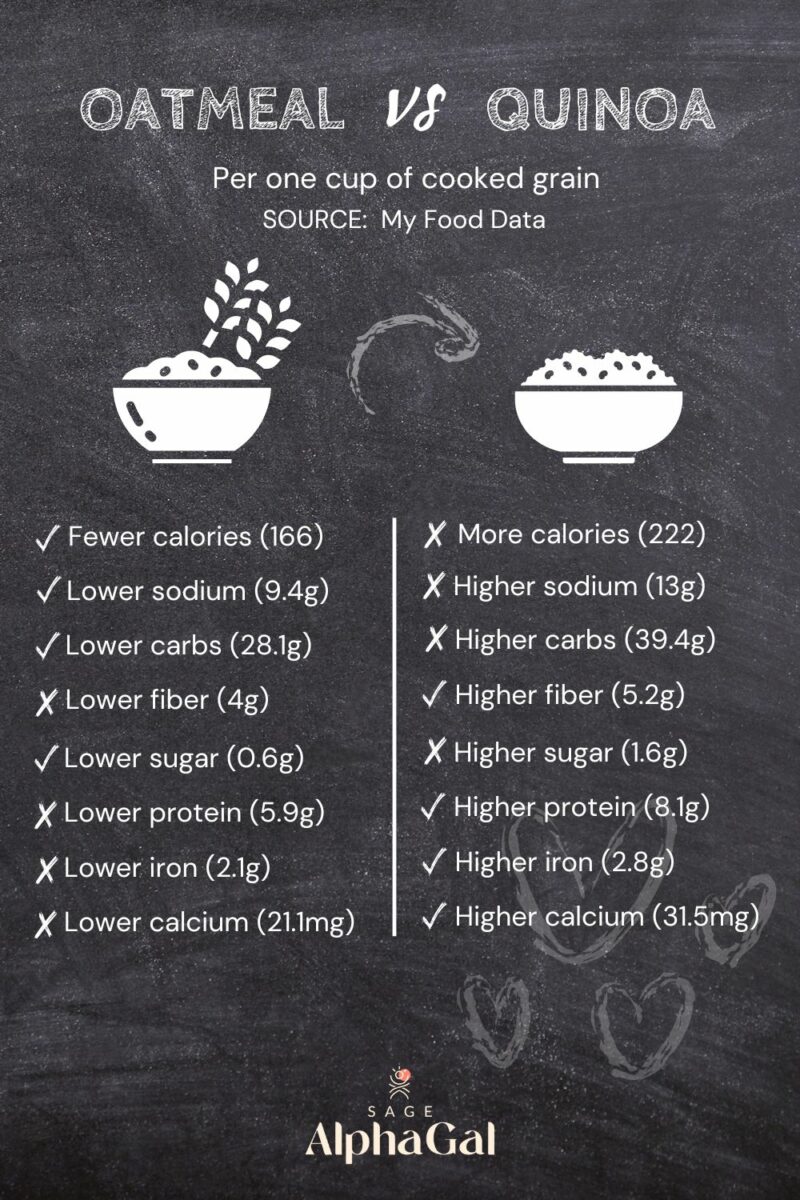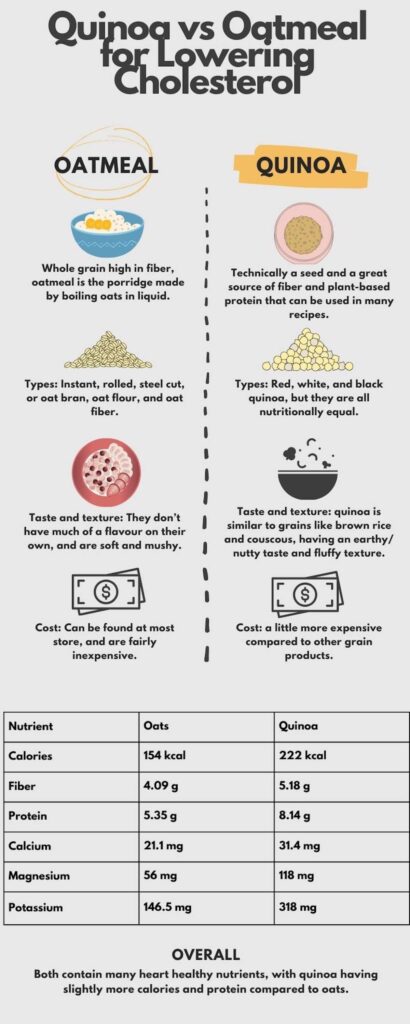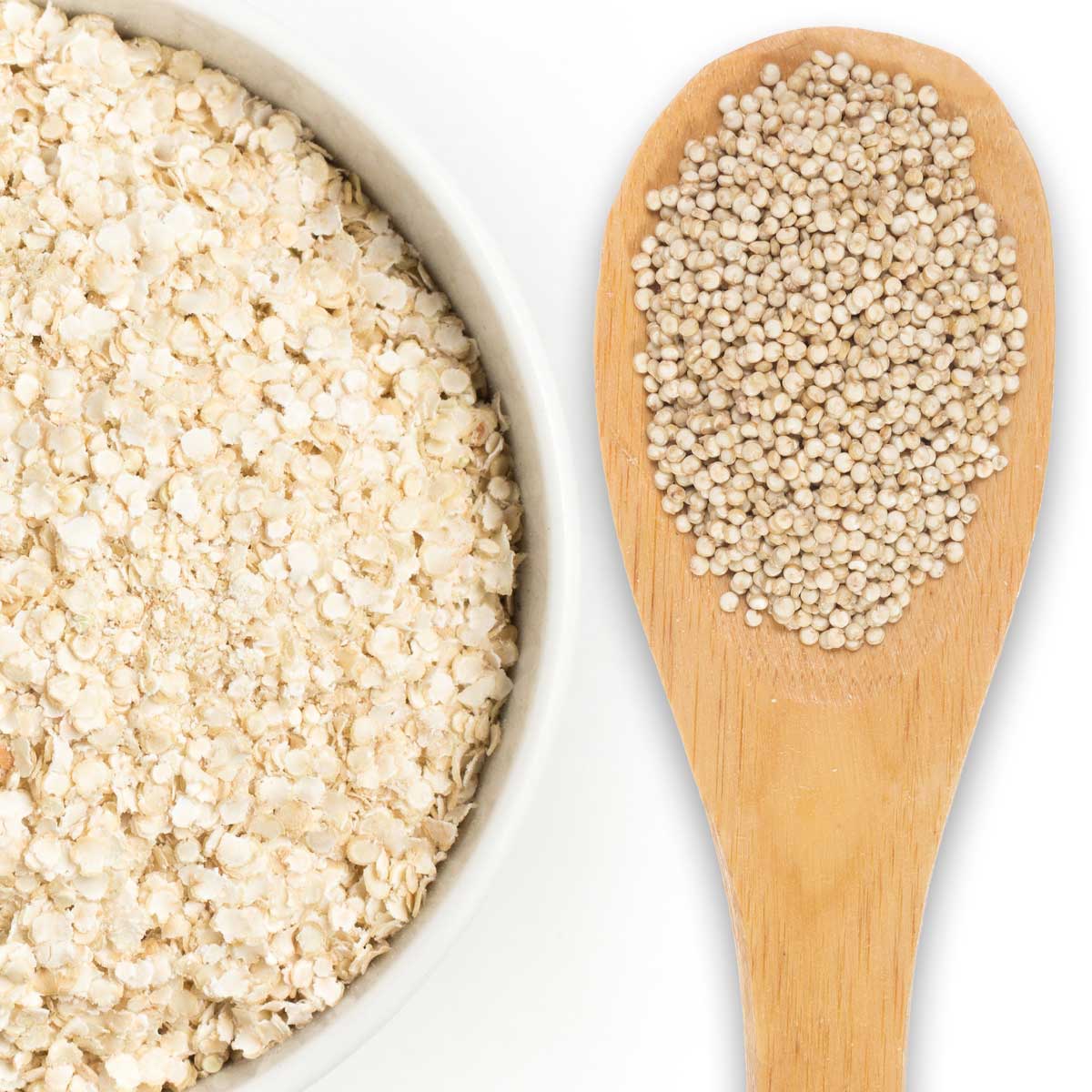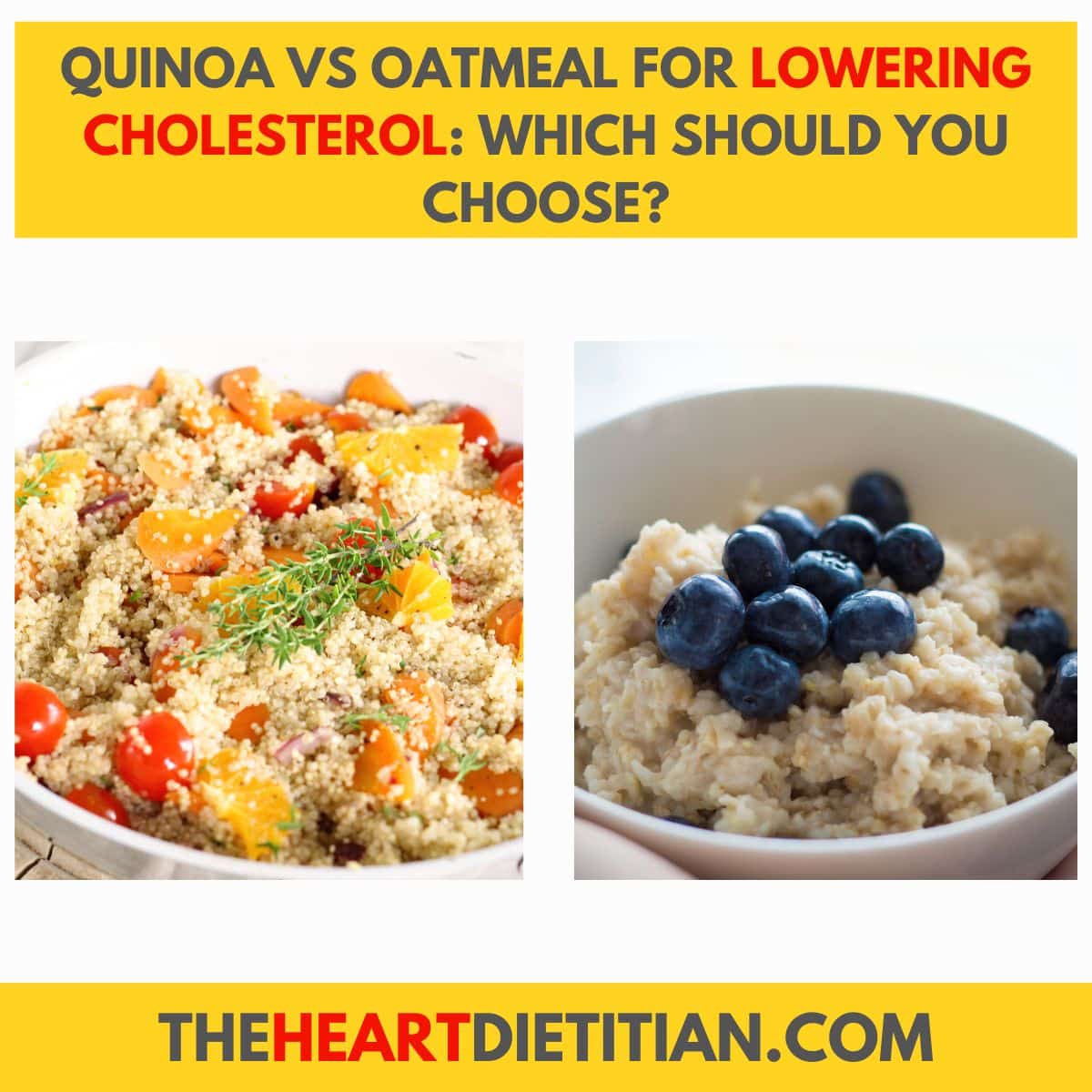Introduction

Oats and quinoa are two popular superfood grains that have gained significant attention for their numerous health benefits. While both grains offer nutritional value, they differ in terms of taste, texture, and environmental impact. This article aims to compare and contrast oats and quinoa in various aspects, such as nutritional value, cooking methods, sustainability, taste, and texture. By understanding the similarities and differences between these superfood grains, individuals can make informed choices and incorporate both oats and quinoa into their balanced diet for optimal health, energy, and performance.
Benefits Of Superfood Grains Oats And Quinoa
Oats and quinoa are both considered superfood grains due to their numerous health benefits. Oats are known for their high fiber content, which can aid in digestion and promote feelings of fullness, making them a great choice for weight management. They are also rich in antioxidants and can help lower cholesterol levels. Quinoa, on the other hand, is a complete protein source, meaning it contains all nine essential amino acids. It is also high in fiber, rich in minerals like magnesium and iron, and gluten-free, making it suitable for those with dietary restrictions. Incorporating both oats and quinoa into your diet can provide a well-rounded nutritional profile and contribute to overall health and well-being.
Nutritional Value
Oats and quinoa both have impressive nutritional profiles that make them excellent choices for a healthy diet. Oats are packed with essential nutrients, including carbohydrates, fiber, calcium, magnesium, and iron. Quinoa, on the other hand, is a complete protein source and is rich in fiber, magnesium, and potassium. Both grains are low in fat and provide a good amount of vitamins and minerals. Incorporating oats and quinoa into your meals can help support overall health and provide a wide range of essential nutrients necessary for optimal bodily function.
Nutrient Comparison Between Oats And Quinoa

When comparing the nutrient content of oats and quinoa, it is evident that both grains offer unique benefits. Oats are known for their high fiber content, providing a satiating effect and promoting digestive health. They also contain essential minerals like calcium, magnesium, and iron. On the other hand, quinoa stands out as a complete protein source and is rich in fiber, magnesium, and potassium. While oats have slightly fewer carbohydrates and less fat than quinoa, the latter is a nutrient powerhouse and a great option for those seeking a plant-based protein alternative. Incorporating both grains into your diet can provide a well-rounded nutrient profile and support overall health.
Health Benefits Of Oats And Quinoa
Oats and quinoa offer numerous health benefits, making them valuable additions to any diet. Oats are known for their high fiber content, which aids in digestion, promotes feelings of fullness, and helps regulate blood sugar levels. They are also rich in antioxidants, which can reduce inflammation and support heart health. Quinoa, on the other hand, is a complete protein and contains all essential amino acids, making it an excellent choice for vegetarians and vegans. Additionally, quinoa is gluten-free and packed with nutrients like magnesium, potassium, and iron, which contribute to overall wellness. Including both oats and quinoa in your diet can provide a wide range of health benefits and support a balanced, nutritious lifestyle.
Cooking And Preparation
When it comes to cooking and preparing oats and quinoa, both grains offer versatility and ease in the kitchen. Oats can be cooked on the stovetop, in the microwave, or even soaked overnight for a convenient and quick breakfast option. With quinoa, the cooking process is straightforward, requiring a simple boil and simmer until the grains are fluffy. Quinoa can be used in a variety of dishes, from salads to stir-fries, making it a versatile ingredient. Both oats and quinoa can be easily incorporated into your diet, providing delicious and nutritious meal options.
Cooking Methods For Oats And Quinoa

When it comes to cooking oats and quinoa, there are various methods that can be used to prepare these superfood grains. Oats can be cooked on the stovetop by combining oats with water or milk and simmering it until it reaches the desired consistency. They can also be microwaved by adding water or milk and cooking it for a few minutes. Additionally, oats can be soaked overnight in yogurt or milk to create overnight oats, a convenient and ready-to-eat breakfast option. On the other hand, quinoa is typically cooked on the stovetop by boiling it in water or broth and then simmering it until the grains are fluffy and tender. This process usually takes about 15-20 minutes. Both oats and quinoa can also be used in various recipes like salads, soups, and stir-fries, providing a versatile and nutritious addition to any meal.
Recipes For Incorporating Oats And Quinoa Into Your Diet
Oats and quinoa are versatile ingredients that can be easily incorporated into a variety of delicious recipes. Here are some ideas to help you add these superfood grains to your diet:
- Overnight oats: Combine oats with your choice of milk or yogurt, add sweeteners like honey or maple syrup, and let it sit in the fridge overnight. In the morning, you’ll have a creamy and nutritious breakfast ready to enjoy.
- Quinoa salad: Cook quinoa according to package instructions and let it cool. Mix it with fresh vegetables, herbs, and a dressing of your choice for a refreshing and filling salad.
- Oatmeal cookies: Use oats as a base for homemade cookies. Combine oats with flour, butter, sugar, and other desired ingredients, then bake until golden brown for a healthy and satisfying treat.
- Quinoa stir-fry: Cook quinoa and set it aside. In a pan, sauté your favorite vegetables, protein (such as tofu or chicken), and seasonings. Add the cooked quinoa and stir-fry everything together for a nutritious and flavorful meal.
Remember, these are just a few ideas to get you started. Don’t be afraid to get creative and experiment with different flavors and ingredients to make your own unique recipes using oats and quinoa. Enjoy the versatility and health benefits of these superfood grains in your everyday meals.
Sustainability And Environmental Impact
When it comes to sustainability and environmental impact, both oats and quinoa have their own unique considerations.
Oats are a more sustainable option as they are a locally grown grain in many regions, reducing the carbon footprint associated with transportation. They also require less water and fertilizer compared to other grains. Additionally, oats are often grown using organic farming practices, minimizing the use of pesticides and chemicals.
On the other hand, quinoa has gained popularity in recent years, leading to increased demand and intensive farming practices in regions like South America. This has raised concerns about water scarcity and soil degradation. However, efforts are being made to promote sustainable quinoa production by implementing proper farming techniques and supporting local communities.
In conclusion, while oats have a lower environmental impact overall, it is important to consider the sourcing and production practices of both grains to make sustainable choices.
Environmental Impact Of Cultivating Oats And Quinoa

Cultivating oats and quinoa has different environmental impacts. Oats have a lower carbon footprint due to being locally grown in many regions, reducing transportation emissions. They also require less water and fertilizer compared to other grains. Additionally, organic farming practices are commonly used for oats, minimizing the use of pesticides and chemicals. On the other hand, the increased demand for quinoa has raised concerns about water scarcity and soil degradation in regions like South America. However, efforts are being made to promote sustainable quinoa production through proper farming techniques and support for local communities.
Sustainable Practices In Oats And Quinoa Production
Sustainable practices in oats and quinoa production are crucial to minimize the environmental impact of these superfood grains. To promote sustainability, farmers are encouraged to adopt organic farming methods for both crops, reducing the use of pesticides and chemicals. Additionally, crop rotation techniques are implemented to maintain soil fertility and prevent soil degradation. Efforts are also being made to improve water management in quinoa-producing regions to address concerns about water scarcity. Sustainable practices not only ensure the long-term availability of oats and quinoa but also protect ecosystems and support local communities.
Taste And Texture
Comparing the taste and texture of oats and quinoa is essential in choosing the right grain for your dishes. Oats have a milder, slightly sweet flavor and a soft texture when cooked. They are often described as comforting and hearty, making them perfect for breakfast porridge or baking. On the other hand, quinoa has a slightly nutty taste and a light, fluffy texture. It is known for its versatility and can be used in a variety of dishes, such as salads, stir-fries, or as a replacement for rice. Both grains offer unique tastes and textures that can be enhanced with the right seasonings and pairings.
Comparing The Taste And Texture Of Oats And Quinoa

Oats and quinoa offer unique taste and texture profiles that can enhance a variety of dishes. Oats have a milder, slightly sweet flavor and a soft texture when cooked. They provide a comforting and hearty experience, making them perfect for breakfast porridge or baking applications. On the other hand, quinoa has a slightly nutty taste and a light, fluffy texture. Its versatility allows it to be used in salads, stir-fries, or as a replacement for rice. By experimenting with different seasonings and pairings, both grains can be transformed into delicious and satisfying meals.
Ways To Enhance The Flavor Of Oats And Quinoa Dishes
There are numerous ways to enhance the flavor of oats and quinoa dishes, allowing you to create delicious and satisfying meals. Consider incorporating the following ingredients and techniques:
- Herbs and spices: Add a burst of flavor with herbs like basil, thyme, or cilantro, or spices like cinnamon, cumin, or turmeric. Experiment with different combinations to find your favorite flavor profile.
- Seasonings: Enhance the taste of oats and quinoa by adding soy sauce, lemon juice, or balsamic vinegar for an extra kick of flavor. You can also try adding nutritional yeast for a cheesy, savory taste.
- Roasting: Roasting oats or quinoa before cooking can bring out their natural nuttiness and add depth to the flavor. Simply spread them on a baking sheet and roast in the oven until golden brown.
- Toasting: Toasting oats or quinoa in a dry skillet before cooking can intensify their flavor and impart a pleasant aroma. Stir them constantly over medium heat until lightly golden.
- Broths and stocks: Cooking oats or quinoa in vegetable or chicken broth instead of water can infuse them with savory flavors, making them more flavorful and enjoyable.
Remember to adjust the seasoning to your taste preferences and experiment with different flavor combinations to create unique and delicious oats and quinoa dishes.
Conclusion
In conclusion, both oats and quinoa are superfood grains that offer numerous health benefits. While oats are high in fiber and can support heart health, quinoa is a complete protein and provides essential amino acids. When it comes to taste and texture, oats have a creamy and comforting quality, while quinoa has a slightly nutty and chewy texture. To enhance the flavor of oats and quinoa dishes, one can incorporate herbs, spices, seasonings, and other flavor-boosting techniques. Ultimately, incorporating both grains into a balanced diet can provide a variety of nutrients and contribute to overall wellness. So, why not enjoy the benefits of both oats and quinoa in your meals?
Final Thoughts On Choosing Between Oats And Quinoa

When it comes to choosing between oats and quinoa, it ultimately depends on your personal preferences and dietary needs. Both grains offer unique nutritional benefits. Oats are high in fiber and can support heart health, while quinoa is a complete protein and provides essential amino acids. Consider your overall dietary patterns and how you can incorporate both grains into your meals for a variety of nutrients. Additionally, consider factors such as cost and availability. Ultimately, incorporating both oats and quinoa into a balanced diet can provide a range of health benefits and contribute to overall wellness.
Recommendations For Incorporating Both Grains Into A Balanced Diet
When it comes to incorporating both oats and quinoa into a balanced diet, there are a few recommendations to consider. First, you can start your day with a hearty bowl of oatmeal topped with fresh fruits and nuts for a satisfying and nutritious breakfast. For lunch or dinner, consider using quinoa as a base for salads, stir-fries, or grain bowls, paired with lean proteins and vegetables. Another option is to use oats and quinoa in baking recipes, such as oatmeal cookies or quinoa muffins, to add a healthy twist to your treats. By incorporating both grains into a variety of meals and snacks, you can enjoy the unique benefits of each and maintain a balanced and nutrient-rich diet.
FAQ About Oats Vs Quinoa: Comparing Superfood Grains
Q: What are the nutritional differences between oats and quinoa?
A: Oats are rich in fiber and beta-glucans, which are known for their heart-healthy benefits. Quinoa, on the other hand, is a complete protein source and contains all nine essential amino acids.
Q: Are oats gluten-free like quinoa?
A: While oats are naturally gluten-free, they can sometimes be cross-contaminated with gluten during processing. Quinoa is naturally gluten-free and safe for those with gluten sensitivities.
Q: How do the cooking methods differ between oats and quinoa?
A: Oats are commonly cooked as oatmeal or used in baking, while quinoa is typically boiled and used as a base for salads, bowls, or as a side dish.
Q: Which grain is more versatile – oats or quinoa?
A: Quinoa is considered more versatile as it can be used in savory or sweet dishes, salads, casseroles, and even in baking. Oats are commonly used in breakfast dishes like oatmeal, granola bars, and cookies.
Q: Are there any differences in the cultivation process of oats and quinoa?
A: Oats are cool-season crops that require moderate rainfall, while quinoa is a hardy plant that thrives in diverse climates and requires less water compared to many other grains.
Q: Can oats and quinoa be consumed raw?
A: While both oats and quinoa can be eaten raw, it is recommended to cook them to improve digestibility and enhance nutrient absorption.

The Bird ‘n’ Bike Cafe ‘n’ Bar is a charming establishment nestled in the heart of Chiltern, Victoria, where locals and visitors alike come together to enjoy delicious food, great company, and a warm, welcoming atmosphere. With 1187 likes and 136 check-ins, it’s clear that the Bird ‘n’ Bike has captured the hearts of many. Our cafe and Bar is open from Wednesday to Sunday, inviting guests to start their day with us from 8 am to 2:30 pm. Whether you prefer to dine in and savor the cozy ambiance or grab a delicious meal, we’ve got you covered.